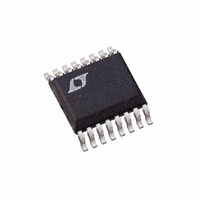LTC3703EGN Linear Technology, LTC3703EGN Datasheet - Page 15

LTC3703EGN
Manufacturer Part Number
LTC3703EGN
Description
IC BUCK/BOOST SYNC ADJ 5A 16SSOP
Manufacturer
Linear Technology
Type
Step-Down (Buck), Step-Up (Boost)r
Datasheet
1.LTC3703EGNPBF.pdf
(32 pages)
Specifications of LTC3703EGN
Internal Switch(s)
No
Synchronous Rectifier
Yes
Number Of Outputs
1
Voltage - Output
0.8 ~ 93 V
Current - Output
5A
Frequency - Switching
100kHz ~ 600kHz
Voltage - Input
9.3 ~ 100 V
Operating Temperature
-40°C ~ 85°C
Mounting Type
Surface Mount
Package / Case
16-SSOP
Lead Free Status / RoHS Status
Contains lead / RoHS non-compliant
Power - Output
-
Available stocks
Company
Part Number
Manufacturer
Quantity
Price
Company:
Part Number:
LTC3703EGN
Manufacturer:
LINEAR
Quantity:
4
Part Number:
LTC3703EGN
Manufacturer:
LTNEAR
Quantity:
20 000
Company:
Part Number:
LTC3703EGN#PBF
Manufacturer:
LT
Quantity:
3 291
Part Number:
LTC3703EGN#PBF
Manufacturer:
LINEAR/凌特
Quantity:
20 000
Company:
Part Number:
LTC3703EGN#TRPBF
Manufacturer:
LT
Quantity:
3 291
Part Number:
LTC3703EGN#TRPBF
Manufacturer:
LTNEAR
Quantity:
20 000
Company:
Part Number:
LTC3703EGN-5
Manufacturer:
LT
Quantity:
10 000
Part Number:
LTC3703EGN-5
Manufacturer:
LINEAR/凌特
Quantity:
20 000
Company:
Part Number:
LTC3703EGN-5#PBF
Manufacturer:
LT
Quantity:
320
Part Number:
LTC3703EGN-5#PBF
Manufacturer:
LINEAR/凌特
Quantity:
20 000
APPLICATIONS INFORMATION
The term (1 + δ) is generally given for a MOSFET in the
form of a normalized R
typically varies from 0.005/°C to 0.01/°C depending on
the particular MOSFET used.
Multiple MOSFETs can be used in parallel to lower R
and meet the current and thermal requirements if desired.
The LTC3703 contains large low impedance drivers capable
of driving large gate capacitances without signifi cantly
slowing transition times. In fact, when driving MOSFETs
with very low gate charge, it is sometimes helpful to slow
down the drivers by adding small gate resistors (5Ω or less)
to reduce noise and EMI caused by the fast transitions.
Schottky Diode Selection
The Schottky diode D1 shown in Figure 1 conducts dur-
ing the dead time between the conduction of the power
MOSFETs. This prevents the body diode of the bottom
MOSFET from turning on and storing charge during the
dead time and requiring a reverse recovery period that could
cost as much as 1% to 2% in effi ciency. A 1A Schottky
diode is generally a good size for 3A to 5A regulators.
Larger diodes result in additional losses due to their larger
junction capacitance. The diode can be omitted if the ef-
fi ciency loss can be tolerated.
Input Capacitor Selection
In continuous mode, the drain current of the top MOSFET
is approximately a square wave of duty cycle V
which must be supplied by the input capacitor. To prevent
large input transients, a low ESR input capacitor sized for
the maximum RMS current is given by:
This formula has a maximum at V
I
used for design because even signifi cant deviations do not
offer much relief. Note that the ripple current ratings from
capacitor manufacturers are often based on only 2000 hours
of life. This makes it advisable to further derate the capacitor
or to choose a capacitor rated at a higher temperature than
O(MAX)
I
CIN RMS
(
/2. This simple worst-case condition is commonly
)
≅
I
O MAX
(
)
V
V
DS(ON)
OUT
IN
⎛
⎝ ⎜
V
vs temperature curve, and
V
OUT
IN
IN
= 2V
–
1
⎞
⎠ ⎟
OUT
1 2
/
, where I
OUT
DS(ON)
RMS
/V
IN
=
required. Several capacitors may also be placed in parallel
to meet size or height requirements in the design.
Because tantalum and OS-CON capacitors are not available
in voltages above 30V, for regulators with input supplies
above 30V, choice of input capacitor type is limited to
ceramics or aluminum electrolytics. Ceramic capacitors
have the advantage of very low ESR and can handle high
RMS current, however ceramics with high voltage ratings
(>50V) are not available with more than a few microfarads
of capacitance. Furthermore, ceramics have high voltage
coeffi cients which means that the capacitance values
decrease even more when used at the rated voltage. X5R
and X7R type ceramics are recommended for their lower
voltage and temperature coeffi cients. Another consider-
ation when using ceramics is their high Q which if not
properly damped, may result in excessive voltage stress
on the power MOSFETs. Aluminum electrolytics have much
higher bulk capacitance, however, they have higher ESR
and lower RMS current ratings.
A good approach is to use a combination of aluminum
electrolytics for bulk capacitance and ceramics for low ESR
and RMS current. If the RMS current cannot be handled
by the aluminum capacitors alone, when used together,
the percentage of RMS current that will be supplied by the
aluminum capacitor is reduced to approximately:
where R
is the overall capacitance of the ceramic capacitors. Using
an aluminum electrolytic with a ceramic also helps damp
the high Q of the ceramic, minimizing ringing.
Output Capacitor Selection
The selection of C
required to minimize voltage ripple. The output ripple
(ΔV
%
Δ
OUT
V
I
OUT
RMS ALUM
) is approximately equal to:
ESR
,
≤
Δ
is the ESR of the aluminum capacitor and C
I ESR
L
⎛
⎝ ⎜
≈
OUT
1 8
+
is primarily determined by the ESR
+
(
8
fC
fCR
1
1
OUT
ESR
⎞
⎠ ⎟
)
2
•
100
LTC3703
%
15
3703fb













